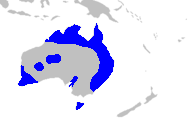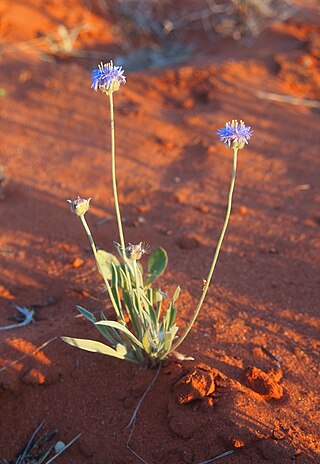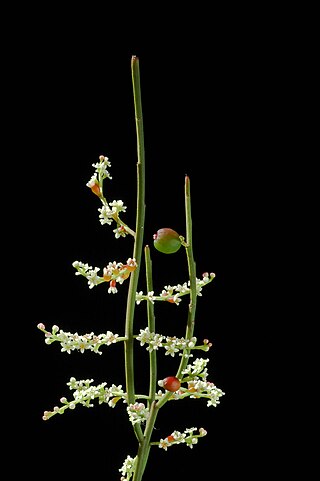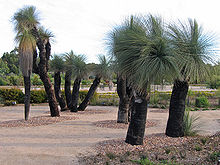
Eucalyptus marginata, commonly known as jarrah, djarraly in Noongar language and historically as Swan River mahogany, is a plant in the myrtle family, Myrtaceae and is endemic to the south-west of Western Australia. It is a tree with rough, fibrous bark, leaves with a distinct midvein, white flowers and relatively large, more or less spherical fruit. Its hard, dense timber is insect resistant although the tree is susceptible to dieback. The timber has been utilised for cabinet-making, flooring and railway sleepers.

Robert Brown was a Scottish botanist and paleobotanist who made important contributions to botany largely through his pioneering use of the microscope. His contributions include one of the earliest detailed descriptions of the cell nucleus and cytoplasmic streaming; the observation of Brownian motion; early work on plant pollination and fertilisation, including being the first to recognise the fundamental difference between gymnosperms and angiosperms; and some of the earliest studies in palynology. He also made numerous contributions to plant taxonomy, notably erecting a number of plant families that are still accepted today; and numerous Australian plant genera and species, the fruit of his exploration of that continent with Matthew Flinders.

Xanthorrhoea is a genus of about 30 species of flowering plants endemic to Australia. Species are known by the name Black Boy.

Cephalotus is a genus which contains one species, Cephalotus follicularis the Albany pitcher plant, a small carnivorous pitcher plant. The pit-fall traps of the modified leaves have inspired the common names for this plant, which include 'Albany pitcher plant", "Western Australian pitcher plant", "Australian pitcher plant", or "fly-catcher plant." It is an evergreen herb that is endemic to peaty swamps in the southwestern corner of Western Australia.

King George Sound is a sound on the south coast of Western Australia. Named King George the Third's Sound in 1791, it was referred to as King George's Sound from 1805. The name "King George Sound" gradually came into use from about 1934, prompted by new Admiralty charts supporting the intention to eliminate the possessive 's' from geographical names.

Flindersia is a genus of 17 species of small to large trees in the family Rutaceae. They have simple or pinnate leaves, flowers arranged in panicles at or near the ends of branchlets and fruit that is a woody capsule containing winged seeds. They grow naturally in Australia, the Moluccas, New Guinea and New Caledonia.

Agonis flexuosa is a species of tree that grows in the southwest of Western Australia. It is easily the most common of the Agonis species, and is one of the most recognisable trees of Western Australia, being commonly grown in parks and on road verges in Perth.

Caladenia, commonly known as spider orchids, is a genus of 350 species of plants in the orchid family, Orchidaceae. Spider orchids are terrestrial herbs with a single hairy leaf and a hairy stem. The labellum is fringed or toothed in most species and there are small projections called calli on the labellum. The flowers have adaptations to attract particular species of insects for pollination. The genus is divided into three groups on the basis of flower shape, broadly, spider orchids, zebra orchids and cowslip orchids, although other common names are often used. Although they occur in other countries, most are Australian and 136 species occur in Western Australia, making it the most species-rich orchid genus in that state.

Adenanthos is a genus of Australian native shrubs in the flowering plant family Proteaceae. Variable in habit and leaf shape, it is the only genus in the family where solitary flowers are the norm. It was discovered in 1791, and formally published by Jacques Labillardière in 1805. The type species is Adenanthos cuneatus, and 33 species are recognised. The genus is placed in subfamily Proteoideae, and is held to be most closely related to several South African genera.

Corymbia calophylla, commonly known as marri, is a species of flowering plant in the family Myrtaceae and is endemic to the southwest of Western Australia. It is a tree or mallee with rough bark on part or all of the trunk, lance-shaped adult leaves, branched clusters of cup-shaped or pear-shaped flower buds, each branch with three or seven buds, white to pink flowers, and relatively large oval to urn-shaped fruit, colloquially known as honky nuts. Marri wood has had many uses, both for Aboriginal people, and in the construction industry.

William Westall was a British landscape artist best known as one of the first artists to work in Australia.

Brunonia australis, commonly known as the blue pincushion or native cornflower, is a perennial or annual herb that grows widely across Australia. It is found in woodlands, open forest and sand plains. In Cronquist's classification scheme it was the sole member of the monogeneric plant family Brunoniaceae. The APG II system moved it into Goodeniaceae, with which it shares the stylar pollen-cup, or indusium, a character confined to these taxa. Brunonia is unique among Goodeniaceae in its radially symmetric flowers, the superior ovary and the absence of endosperm in the seeds.

Xanthorrhoea australis, the grass tree or austral grasstree, is an Australian plant. It is the most commonly seen species of the genus Xanthorrhoea. Its trunk can grow up to several metres tall and is often branched. In certain Aboriginal languages, it is called bukkup, baggup or kawee.

Macrozamia riedlei, commonly known as a zamia or zamia palm, is a species of cycad in the plant family Zamiaceae. It is endemic to southwest Australia and often occurs in jarrah forests. It may only attain a height of half a metre or form an above trunk up to two metres with long arching fronds of a similar length. The giant cones amidst the crown of palm-like fronds contain edible seeds surrounded by red sarcotesta. The seeds are consumed by birds and animals, and can be a favoured part of the human diet when prepared correctly. M. riedlei benefits from a close association with bacteria that fix nitrogen, which also produce substances found throughout the plant that are toxic to some animals when consumed. The species is cultivated for ornamental use in urban and domestic environments.

Character and description of Kingia, a new genus of plants found on the south-west coast of New Holland, with observations on the structure of its unimpregnated ovulum, and on the female flower of Cycadeae and Coniferae is an 1826 paper by botanist Robert Brown. Though nominally a formal description of the then-unpublished genus Kingia, it is more notable for its digressions into ovule anatomy and development, in which Brown sets out for the first time the modern understanding of the structure of angiosperm ovules, and publishes the first description of the fundamental difference between angiosperms and gymnosperms. Of the latter it has been said that "no more important discovery was ever made in the domain of comparative morphology and systematic Botany".

Flindersia australis, commonly known as crow's ash, flindosy or Australian teak, is a species of tree that is endemic to north-eastern Australia. It has pinnate leaves with between five and thirteen egg-shaped to elliptical leaflets, white to cream-coloured flowers arranged in panicles on the ends of branchlets and followed by woody capsules studded with short, rough points and containing winged seeds.

Isopogon ceratophyllus, commonly known as the horny cone-bush or wild Irishman, is a plant of the family Proteaceae that is endemic to the coast in Victoria, South Australia and on the Furneaux Group of islands in Tasmania. It is a small woody shrub that grows to 100 cm high with prickly foliage. It is extremely sensitive to dieback from the pathogen Phytophthora cinnamomi

Synaphea spinulosa is a species of small shrub in the flowering plant family Proteaceae. It is endemic to Western Australia. Together with Acacia truncata, it was the first Australian endemic to be scientifically described and named, and the specimen upon which that description is based is the oldest extant specimen of an Australian plant, and very likely among the first Australian plant specimens ever collected.

Xanthorrhoea gracilis, commonly known as the graceful grasstree, grassboy or mimidi, is a species of grasstree of the genus Xanthorrhoea native to Western Australia.

Leptomeria drupacea, also known as the pale currant bush, is an endemic Australian hemi-parasitic erect shrub. It occurs commonly in dry woodlands across Tasmania Australia and in some parts of Victoria and Queensland. It has long yellowish-green slender branchlets that often give a broom-like appearance.

























